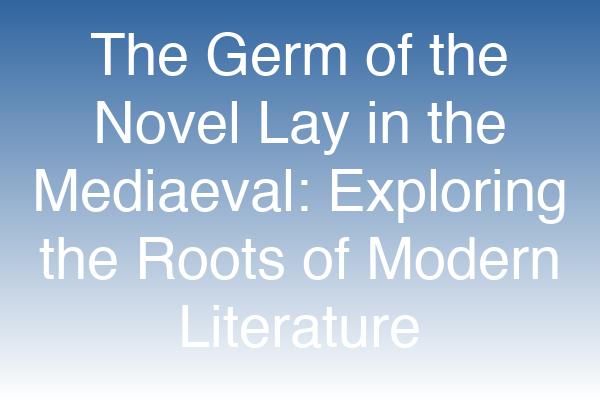
Introduction
The evolution of literature is a fascinating journey, with roots that stretch deep into history. One of the most intriguing aspects of this evolution is how the germ of the novel lay in the mediaeval era. This period, often characterized by its rich tapestry of stories, themes, and characters, laid the groundwork for what we now recognize as the modern novel. In this blog post, we will explore how mediaeval literature influenced contemporary storytelling, examining key works, themes, and the cultural context that fostered this literary transformation.
The Mediaeval Influence on Storytelling
The Rise of Narrative Complexity
During the mediaeval period, storytelling began to shift from oral traditions to written forms. This transition allowed for greater narrative complexity, which is a hallmark of the modern novel. Works such as The Canterbury Tales by Geoffrey Chaucer and The Divine Comedy by Dante Alighieri introduced multi-layered narratives and diverse character perspectives, setting a precedent for future novelists.
Key Themes in Mediaeval Literature
Mediaeval literature often explored themes of chivalry, love, and morality, which resonate in today’s novels. The concept of courtly love, for instance, found in works like Tristan and Isolde, influenced countless romantic narratives in modern literature. These themes not only captivated audiences but also provided a moral framework that many contemporary authors still draw upon.
Character Development: From Archetypes to Complexity
In the mediaeval era, characters were often archetypal, representing broader societal roles. However, as literature progressed, these characters began to evolve into more complex figures. For example, the transition from the idealized knight in mediaeval romances to the flawed protagonists of modern novels illustrates this shift. This complexity allows readers to engage more deeply with characters, making their journeys more relatable and impactful.
The Transition to the Novel
The Emergence of Prose Fiction
The germ of the novel lay not only in thematic and character development but also in the form itself. The rise of prose fiction in the late mediaeval period, exemplified by works like The Decameron by Boccaccio, marked a significant departure from poetry and verse. This shift allowed for more extensive storytelling and the exploration of everyday life, paving the way for the novel as a literary form.
Influence of Historical Context
The mediaeval period was marked by significant historical events, such as the Crusades and the Black Death, which influenced literature profoundly. These events provided rich material for storytelling, allowing authors to reflect on human experiences, societal changes, and moral dilemmas. This historical context is crucial for understanding how the mediaeval era shaped the narratives we see in modern novels.
Modern Reflections of Mediaeval Themes
The Legacy of Mediaeval Literature in Contemporary Novels
Today, many authors draw inspiration from mediaeval literature, consciously or unconsciously weaving its themes and styles into their works. For instance, fantasy novels like J.R.R. Tolkien's The Lord of the Rings echo mediaeval motifs of heroism, quests, and moral struggles. Similarly, contemporary romance often revisits the ideals of courtly love, showcasing its enduring influence.
Case Studies: Mediaeval Influence in Modern Works
Game of Thrones by George R.R. Martin: This series is heavily influenced by mediaeval history, featuring complex characters and intricate political plots reminiscent of mediaeval romances and historical narratives.
The Name of the Rose by Umberto Eco: This novel directly engages with mediaeval themes, combining mystery with philosophical and historical inquiries, showcasing how deeply mediaeval literature can inform modern storytelling.
Conclusion
In conclusion, the assertion that the germ of the novel lay in the mediaeval is not merely a historical observation but a testament to the enduring legacy of this rich literary period. The themes, character complexities, and narrative forms that emerged during the mediaeval era continue to resonate in modern literature, shaping the way stories are told today. As readers and writers, we can appreciate the intricate tapestry of influences that connect us to our literary past.
Call to Action
What are your favorite novels that reflect mediaeval themes? Share your thoughts in the comments below, and let’s explore how the past continues to shape our literary landscape!
This blog post is designed to be engaging, informative, and optimized for search engines while providing valuable insights into the connection between mediaeval literature and the modern novel.